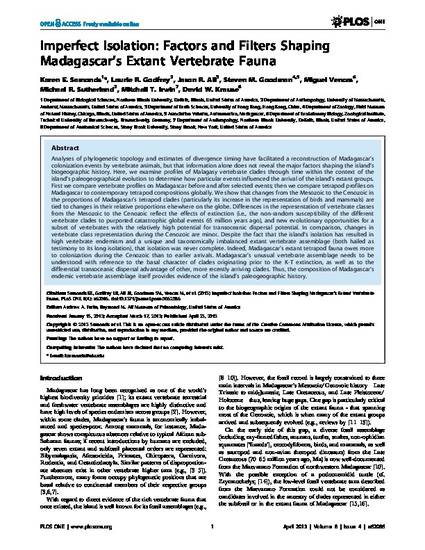
Article
Imperfect Isolation: Factors and Filters Shaping Madagascar’s Extant Vertebrate Fauna
PLOS One
(2013)
Abstract
Analyses of phylogenetic topology and estimates of divergence timing have facilitated a reconstruction of Madagascar’s colonization events by vertebrate animals, but that information alone does not reveal the major factors shaping the island’s biogeographic history. Here, we examine profiles of Malagasy vertebrate clades through time within the context of the island’s paleogeographical evolution to determine how particular events influenced the arrival of the island’s extant groups. First we compare vertebrate profiles on Madagascar before and after selected events; then we compare tetrapod profiles on Madagascar to contemporary tetrapod compositions globally. We show that changes from the Mesozoic to the Cenozoic in the proportions of Madagascar’s tetrapod clades (particularly its increase in the representation of birds and mammals) are tied to changes in their relative proportions elsewhere on the globe. Differences in the representation of vertebrate classes from the Mesozoic to the Cenozoic reflect the effects of extinction (i.e., the non-random susceptibility of the different vertebrate clades to purported catastrophic global events 65 million years ago), and new evolutionary opportunities for a subset of vertebrates with the relatively high potential for transoceanic dispersal potential. In comparison, changes in vertebrate class representation during the Cenozoic are minor. Despite the fact that the island’s isolation has resulted in high vertebrate endemism and a unique and taxonomically imbalanced extant vertebrate assemblage (both hailed as testimony to its long isolation), that isolation was never complete. Indeed, Madagascar’s extant tetrapod fauna owes more to colonization during the Cenozoic than to earlier arrivals. Madagascar’s unusual vertebrate assemblage needs to be understood with reference to the basal character of clades originating prior to the K-T extinction, as well as to the differential transoceanic dispersal advantage of other, more recently arriving clades. Thus, the composition of Madagascar’s endemic vertebrate assemblage itself provides evidence of the island's paleogeographic history.
Disciplines
Publication Date
2013
Publisher Statement
doi:10.1371/journal.pone.0062086
Citation Information
Karen E. Samonds, Laurie Godfrey, Jason R. Ali, Steven M. Goodman, et al.. "Imperfect Isolation: Factors and Filters Shaping Madagascar’s Extant Vertebrate Fauna" PLOS One Vol. 8 Iss. 4 (2013) Available at: http://works.bepress.com/laurie_godfrey/116/
